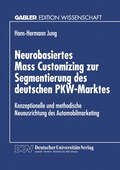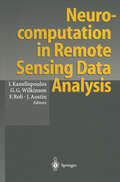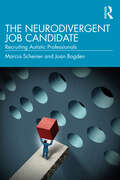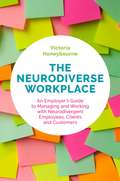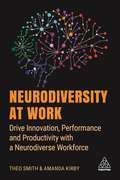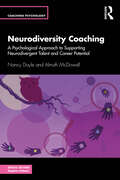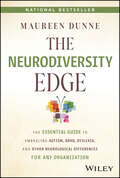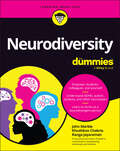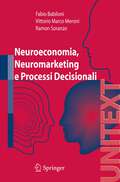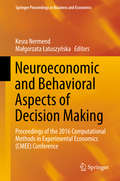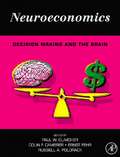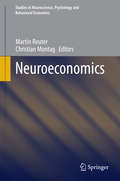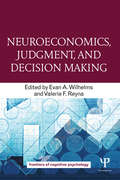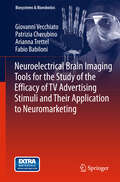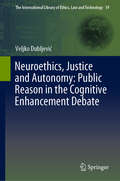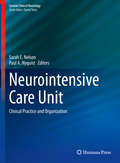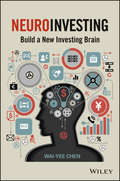- Table View
- List View
Neurobasiertes Mass Customizing zur Segmentierung des deutschen PKW-Marktes: Konzeptionelle und methodische Neuausrichtung des Automobilmarketing
by Hans-Hermann JungNeuronale Netze sind besser als traditionelle Berechnungsverfahren geeignet, sowohl die Komplexität als auch die Nichtlinearität des Verhaltens von Automobilkäufern abzubilden und zu erklären.
Neurocomputation in Remote Sensing Data Analysis: Proceedings of Concerted Action COMPARES (Connectionist Methods for Pre-Processing and Analysis of Remote Sensing Data)
by JamesAustin FabioRoli Graeme G. Wilkinson IoannisKanellopoulosA state-of-the-art view of recent developments in the use of artificial neural networks for analysing remotely sensed satellite data. Neural networks, as a new form of computational paradigm, appear well suited to many of the tasks involved in this image analysis. This book demonstrates a wide range of uses of neural networks for remote sensing applications and reports the views of a large number of European experts brought together as part of a concerted action supported by the European Commission.
The Neurodivergent Job Candidate: Recruiting Autistic Professionals
by Joan Bogden Marcia ScheinerThis book provides guidance on recruiting, interviewing, and onboarding practices that will allow employers to successfully hire neurodivergent professionals into inclusive, competitive employment. Today, 35% of 18-year-olds with an autism spectrum diagnosis attend college, yet they have a 75–85% under-employment and unemployment rate after graduation. While organizations are looking to expand their diversity and inclusion hiring efforts to include neurodivergent professionals, current recruiting and interviewing practices in general are not well-suited to this. With over one-third of the US population identifying as neurodivergent, employers need to address how to attract this talent pool to take advantage of a meaningful segment of the workforce. Readers of this book will gain an understanding of how to guide their organizations through the creation of recruiting, interviewing, and onboarding processes tailored to neurodivergent professionals in any field. Written by authors with extensive experience working in the corporate world and consulting with Fortune 1000 companies on autism hiring efforts, this book is targeted at employers, acknowledging their perspective. Structured as a reference guide for busy recruiters, hiring managers, and supervisors, this book can be read in its entirety, in relevant sections as needed, or used as a refresher whenever necessary. This book also provides a background on the thinking styles of autistic individuals, giving the reader a deeper understanding of how to best support neurodivergent jobseekers.
The Neurodivergent Job Candidate: Recruiting Autistic Professionals
by Joan Bogden Marcia ScheinerThis book provides guidance on recruiting, interviewing, and onboarding practices that will allow employers to successfully hire neurodivergent professionals into inclusive, competitive employment. Today, 35% of 18-year-olds with an autism spectrum diagnosis attend college, yet they have a 75–85% under-employment and unemployment rate after graduation. While organizations are looking to expand their diversity and inclusion hiring efforts to include neurodivergent professionals, current recruiting and interviewing practices in general are not well-suited to this. With over one-third of the US population identifying as neurodivergent, employers need to address how to attract this talent pool to take advantage of a meaningful segment of the workforce. Readers of this book will gain an understanding of how to guide their organizations through the creation of recruiting, interviewing, and onboarding processes tailored to neurodivergent professionals in any field. Written by authors with extensive experience working in the corporate world and consulting with Fortune 1000 companies on autism hiring efforts, this book is targeted at employers, acknowledging their perspective. Structured as a reference guide for busy recruiters, hiring managers, and supervisors, this book can be read in its entirety, in relevant sections as needed, or used as a refresher whenever necessary. This book also provides a background on the thinking styles of autistic individuals, giving the reader a deeper understanding of how to best support neurodivergent jobseekers.
The Neurodiverse Workplace: An Employer’s Guide to Managing and Working with Neurodivergent Employees, Clients and Customers
by Victoria HoneybourneEstimates suggest that up to 20% of employees, customers and clients might have a neurodivergent condition - such as dyslexia, autism, Asperger's, ADHD or dyspraxia - yet these individuals often struggle to gain and maintain employment, despite being very capable. This practical, authoritative business guide will help managers and employers support neurodiverse staff, and gives advice on how to ensure workplaces are neuro-friendly. The book demonstrates that neurodiversity is a natural aspect of human variation to be expected and accepted, rather than a deficit to be accommodated. Employer responsibilities are highlighted, including the 2010 Equality Act, and a range of strategies and policies are provided, including recruitment advice and the benefits of neurodiverse employees, along with advice on physical environments, interaction and communication, and working with clients and customers. This book is an ideal resource for all employers wanting to support and empower people with specific needs to help create a more inclusive workplace, benefiting both neurodiverse individuals and the companies employing them.
The Neurodiverse Workplace: An Employer’s Guide to Managing and Working with Neurodivergent Employees, Clients and Customers
by Victoria HoneybourneEstimates suggest that up to 20% of employees, customers and clients might have a neurodivergent condition - such as dyslexia, autism, Asperger's, ADHD or dyspraxia - yet these individuals often struggle to gain and maintain employment, despite being very capable. This practical, authoritative business guide will help managers and employers support neurodiverse staff, and gives advice on how to ensure workplaces are neuro-friendly. The book demonstrates that neurodiversity is a natural aspect of human variation to be expected and accepted, rather than a deficit to be accommodated. Employer responsibilities are highlighted, including the 2010 Equality Act, and a range of strategies and policies are provided, including recruitment advice and the benefits of neurodiverse employees, along with advice on physical environments, interaction and communication, and working with clients and customers. This book is an ideal resource for all employers wanting to support and empower people with specific needs to help create a more inclusive workplace, benefiting both neurodiverse individuals and the companies employing them.
Neurodiversity at Work: Drive Innovation, Performance and Productivity with a Neurodiverse Workforce
by Amanda Kirby Theo SmithAn organization's employees are its biggest competitive advantage. Performance gains can be achieved through cost saving, process improvement or technology adoption, but the biggest difference is made by people. This means that recruiting, engaging and retaining the very best talent has never been more important.Crucially, these employees should be a diverse group of people with different approaches, skills and strengths in problem-solving and driving innovation. As well as focusing on gender, race, age and class, it is critical that businesses also develop a neurodiverse workforce if they are committed to outperforming the competition and achieving sustainable business growth.Neurodiversity at Work is a practical guide that explains what neurodiversity is, why it's important and what the benefits are. It covers how to attract, recruit and engage neurodiverse talent and provides guidance on how to adapt HR policies, processes and workplaces to ensure that all employees, including the 2 in 10 employees in the UK who are neurodiverse, can reach their full potential. Neurodiversity at Work is packed full of case studies from leading organizations like Microsoft who are already seeing the productivity, performance and financial benefits of neurodiversity in the workplace. Individuals in these companies are also experiencing benefits in their working environments. Also featured are interviews with prominent figures in the neurodiversity community and people who have successfully adapted their HR processes for neurodiversity, including members of the ND@IBM Program and the Head of People and Culture at Autotrader. With tips, advice, examples and 'how to' actions in every chapter, this is essential reading for every HR professional.
Neurodiversity at Work: Drive Innovation, Performance and Productivity with a Neurodiverse Workforce
by Amanda Kirby Theo SmithAn organization's employees are its biggest competitive advantage. Performance gains can be achieved through cost saving, process improvement or technology adoption, but the biggest difference is made by people. This means that recruiting, engaging and retaining the very best talent has never been more important.Crucially, these employees should be a diverse group of people with different approaches, skills and strengths in problem-solving and driving innovation. As well as focusing on gender, race, age and class, it is critical that businesses also develop a neurodiverse workforce if they are committed to outperforming the competition and achieving sustainable business growth.Neurodiversity at Work is a practical guide that explains what neurodiversity is, why it's important and what the benefits are. It covers how to attract, recruit and engage neurodiverse talent and provides guidance on how to adapt HR policies, processes and workplaces to ensure that all employees, including the 2 in 10 employees in the UK who are neurodiverse, can reach their full potential. Neurodiversity at Work is packed full of case studies from leading organizations like Microsoft who are already seeing the productivity, performance and financial benefits of neurodiversity in the workplace. Individuals in these companies are also experiencing benefits in their working environments. Also featured are interviews with prominent figures in the neurodiversity community and people who have successfully adapted their HR processes for neurodiversity, including members of the ND@IBM Program and the Head of People and Culture at Autotrader. With tips, advice, examples and 'how to' actions in every chapter, this is essential reading for every HR professional.
Neurodiversity Coaching: A Psychological Approach to Supporting Neurodivergent Talent and Career Potential (Coaching Psychology)
by Nancy Doyle Almuth McDowall- neurodiversity coaching is an emerging field, the topic of neurodiversity has been increasing in the past decade and general awareness is growing - this book will be the first, broad publication on neurodiversity coaching - uses science-based methodology
Neurodiversity Coaching: A Psychological Approach to Supporting Neurodivergent Talent and Career Potential (Coaching Psychology)
by Nancy Doyle Almuth McDowall- neurodiversity coaching is an emerging field, the topic of neurodiversity has been increasing in the past decade and general awareness is growing - this book will be the first, broad publication on neurodiversity coaching - uses science-based methodology
The Neurodiversity Edge: The Essential Guide to Embracing Autism, ADHD, Dyslexia, and Other Neurological Differences for Any Organization
by Maureen DunneIn The Neurodiversity Edge, renowned Oxford-trained cognitive scientist, neurodiversity expert, and business leader, Dr. Maureen Dunne presents a pioneering framework to harnessing the power of neurodiversity to navigate the most important human resources revolution in the modern era. Did you know that an estimated 1 in 5 people are “neurodivergent”—have a mind that works differently, such as the autistic, ADHDers, the dyslexic, synesthetes, and other unique neurotypes—and that the vast majority are motivated, capable, and unemployed? This indispensable guide is based on more than two decades of immersive cognitive science research, case studies, stories from neurodivergent voices, in-the-trenches work with hundreds of organizations from start-ups to global Fortune 500 titans, and Dr. Dunne's own lived experiences as a neurodivergent employer, entrepreneur, board member, and CEO. Too many unique minds and perspectives on the sidelines, and too many organizations beset by groupthink, innovation-stagnation, and a lack of access to qualified new candidates. The Neurodiversity Edge takes you all the way from why to what and to how, delivering practical insights that build on a new foundational framework: Cultivate a values-driven approach to building a culture of sustained authentic inclusion where everyone can thrive, How to improve the interview process to avoid missing game-changing talent Develop a hybrid office protocol that works for everyone and a support infrastructure that aligns with universal design principles Discover why Google's Project Aristotle found that innovation and performance hinge on psychological safety Uncover and eliminate the destructive influence of unconscious cognitive biases Take a graphic tour into the wonders of the human mind Understand unique problem-solving abilities such as lateral thinking, visual-spatial thinking, multisensory thinking, leaps of creative insight, hyperfocus, and many more How to articulate and implement organizational goals and measure progress toward them The Neurodiversity Edge is an essential guide for executives, board directors, human resources professionals, managers, recruiters, entrepreneurs, venture capitalists, allies, educators, nonprofit leaders, and anyone with an interest in better understanding neurodiversity, authentic neuroinclusion, and the human mind.
The Neurodiversity Edge: The Essential Guide to Embracing Autism, ADHD, Dyslexia, and Other Neurological Differences for Any Organization
by Maureen DunneIn The Neurodiversity Edge, renowned Oxford-trained cognitive scientist, neurodiversity expert, and business leader, Dr. Maureen Dunne presents a pioneering framework to harnessing the power of neurodiversity to navigate the most important human resources revolution in the modern era. Did you know that an estimated 1 in 5 people are “neurodivergent”—have a mind that works differently, such as the autistic, ADHDers, the dyslexic, synesthetes, and other unique neurotypes—and that the vast majority are motivated, capable, and unemployed? This indispensable guide is based on more than two decades of immersive cognitive science research, case studies, stories from neurodivergent voices, in-the-trenches work with hundreds of organizations from start-ups to global Fortune 500 titans, and Dr. Dunne's own lived experiences as a neurodivergent employer, entrepreneur, board member, and CEO. Too many unique minds and perspectives on the sidelines, and too many organizations beset by groupthink, innovation-stagnation, and a lack of access to qualified new candidates. The Neurodiversity Edge takes you all the way from why to what and to how, delivering practical insights that build on a new foundational framework: Cultivate a values-driven approach to building a culture of sustained authentic inclusion where everyone can thrive, How to improve the interview process to avoid missing game-changing talent Develop a hybrid office protocol that works for everyone and a support infrastructure that aligns with universal design principles Discover why Google's Project Aristotle found that innovation and performance hinge on psychological safety Uncover and eliminate the destructive influence of unconscious cognitive biases Take a graphic tour into the wonders of the human mind Understand unique problem-solving abilities such as lateral thinking, visual-spatial thinking, multisensory thinking, leaps of creative insight, hyperfocus, and many more How to articulate and implement organizational goals and measure progress toward them The Neurodiversity Edge is an essential guide for executives, board directors, human resources professionals, managers, recruiters, entrepreneurs, venture capitalists, allies, educators, nonprofit leaders, and anyone with an interest in better understanding neurodiversity, authentic neuroinclusion, and the human mind.
Neurodiversity For Dummies
by John Marble Khushboo Chabria Ranga JayaramanA quick and easy way to understand neurodiversity as written by neurodivergent people and our families Neurodiversity For Dummies is your essential guide in understanding neurodivergent conditions like autism, ADHD, dyslexia, and more. This quick and easy guide is perfect for anyone needing to know more about neurodiversity. And that’s all of us—because recent estimates say that 15-20% of the world’s population have some form of neurodivergence. Your life is filled with neurodivergent people that you know and love, whether you realize it yet or not. It’s time to learn to support and include the neurodivergent among us, and to understand how neurodiversity impacts society and the workplace. This is for the neurodivergent person wanting to thrive in life, for parents and caregivers seeking success for their child, and for teachers who are working to make a difference in their students’ lives. Filled with practical advice, Neurodiversity for Dummies also provides a helping hand to service providers, assistance for workplace managers and colleagues, and understanding for family members and friends. Imagine a world where we all understood ourselves better and appreciated more deeply the differences in others. No matter how your own brain thinks, Neurodiversity for Dummies is for you. Check out this jargon-free introduction for an essential overview. Explore the Spectrum of Neurodiversity: Understand in plain language the world of autism, ADHD, dyslexia, and other neurodivergent conditions. Unlock Hidden Talents: Move yourself beyond common myths and misconceptions to discover how neurodiversity actually works. Learn how neurodiversity has always been with us, why society needs neurodivergent traits, and how neurodiversity can be a wellspring of innovation, creativity, and out-of-the-box thinking. Discover Yourself: Whether you are a neurodivergent person or not, learn how to understand your own normalcy, advocate for your needs, and build meaningful connections with those who think and experience the world differently than you. Change the World Around You: Be empowered through simple steps you can take to create inclusive environments for neurodivergent individuals in your school or workplace. Uncover proven strategies that cultivate a culture of acceptance and respect, where the unique perspectives of all individuals are valued and celebrated. We believe in providing parents with better supports, empowering individuals with information, and shaping a world where we are all seen and understood. With an author team composed of neurodivergent individuals and parents writing together, Neurodiversity for Dummies is an example of the power of neurodiversity when put into action. It’s why we wrote this for you. Don’t miss your chance to embark on this transformative journey. Order your copy of Neurodiversity for Dummies now to better understand yourself and others, and to join the movement that is revolutionizing how we understand and support the diversity of the human mind.
Neurodiversity For Dummies
by John Marble Khushboo Chabria Ranga JayaramanA quick and easy way to understand neurodiversity as written by neurodivergent people and our families Neurodiversity For Dummies is your essential guide in understanding neurodivergent conditions like autism, ADHD, dyslexia, and more. This quick and easy guide is perfect for anyone needing to know more about neurodiversity. And that’s all of us—because recent estimates say that 15-20% of the world’s population have some form of neurodivergence. Your life is filled with neurodivergent people that you know and love, whether you realize it yet or not. It’s time to learn to support and include the neurodivergent among us, and to understand how neurodiversity impacts society and the workplace. This is for the neurodivergent person wanting to thrive in life, for parents and caregivers seeking success for their child, and for teachers who are working to make a difference in their students’ lives. Filled with practical advice, Neurodiversity for Dummies also provides a helping hand to service providers, assistance for workplace managers and colleagues, and understanding for family members and friends. Imagine a world where we all understood ourselves better and appreciated more deeply the differences in others. No matter how your own brain thinks, Neurodiversity for Dummies is for you. Check out this jargon-free introduction for an essential overview. Explore the Spectrum of Neurodiversity: Understand in plain language the world of autism, ADHD, dyslexia, and other neurodivergent conditions. Unlock Hidden Talents: Move yourself beyond common myths and misconceptions to discover how neurodiversity actually works. Learn how neurodiversity has always been with us, why society needs neurodivergent traits, and how neurodiversity can be a wellspring of innovation, creativity, and out-of-the-box thinking. Discover Yourself: Whether you are a neurodivergent person or not, learn how to understand your own normalcy, advocate for your needs, and build meaningful connections with those who think and experience the world differently than you. Change the World Around You: Be empowered through simple steps you can take to create inclusive environments for neurodivergent individuals in your school or workplace. Uncover proven strategies that cultivate a culture of acceptance and respect, where the unique perspectives of all individuals are valued and celebrated. We believe in providing parents with better supports, empowering individuals with information, and shaping a world where we are all seen and understood. With an author team composed of neurodivergent individuals and parents writing together, Neurodiversity for Dummies is an example of the power of neurodiversity when put into action. It’s why we wrote this for you. Don’t miss your chance to embark on this transformative journey. Order your copy of Neurodiversity for Dummies now to better understand yourself and others, and to join the movement that is revolutionizing how we understand and support the diversity of the human mind.
Neuroeconomia, neuromarketing e processi decisionali nell uomo (UNITEXT)
by Fabio Babiloni Vittorio Meroni Ramon SoranzoL’obbiettivo di questo libro è quello di presentare in maniera razionale un nuovo insieme di conoscenze circa il funzionamento cerebrale in merito alle scelte di tipo economico. In particolare si vuole fare colmare una lacuna nella editoria italiana relativa a questi temi, che spesso vengono comunicati in maniera imprecisa e scandalistica dai giornali e dai mass media. Il libro fornisce alcuni strumenti scientifici per affrontare il problema di come il nostro cervello genera delle scelte in campo economico, in un linguaggio piano e non specialistico. Vengono descritti i risultati del primo studio italiano relativo all’osservazione di filmati commerciali televisivi, analizzati mediante l’elettroencefalografia ad alta risoluzione spaziale. La neuroeconomia è una nuova scienza che si sta sviluppando rapidamente nei paesi anglosassoni. Questo libro spiega i concetti di neuroeconomia e neuromarketing anche al pubblico italiano.
Neuroeconomic and Behavioral Aspects of Decision Making: Proceedings of the 2016 Computational Methods in Experimental Economics (CMEE) Conference (Springer Proceedings in Business and Economics)
by Kesra Nermend Małgorzata ŁatuszyńskaThis proceedings volume presents the latest scientific research and trends in experimental economics, with particular focus on neuroeconomics. Derived from the 2016 Computational Methods in Experimental Economics (CMEE) conference held in Szczecin, Poland, this book features research and analysis of novel computational methods in neuroeconomics. Neuroeconomics is an interdisciplinary field that combines neuroscience, psychology and economics to build a comprehensive theory of decision making. At its core, neuroeconomics analyzes the decision-making process not only in terms of external conditions or psychological aspects, but also from the neuronal point of view by examining the cerebral conditions of decision making. The application of IT enhances the possibilities of conducting such analyses. Such studies are now performed by software that provides interaction among all the participants and possibilities to register their reactions more accurately. This book examines some of these applications and methods. Featuring contributions on both theory and application, this book is of interest to researchers, students, academics and professionals interested in experimental economics, neuroeconomics and behavioral economics.
Neuroeconomics: Decision Making and the Brain
by Paul W. Glimcher Colin Camerer Ernst Fehr Russell Alan PoldrackNeuroeconomics is a new highly promising approach to understanding the neurobiology of decision making and how it affects cognitive social interactions between humans and societies/economies. This book is the first edited reference to examine the science behind neuroeconomics, including how it influences human behavior and societal decision making from a behavioral economics point of view. Presenting a truly interdisciplinary approach, Neuroeconomics presents research from neuroscience, psychology, and behavioral economics, and includes chapters by all the major figures in the field, including two Economics Nobel laureates.* An authoritative reference written and edited by acknowledged experts and founders of the field * Presents an interdisciplinary view of the approaches, concepts, and results of the emerging field of neuroeconomics relevant for anyone interested in this area of research* Full-color presentation throughout with carefully selected illustrations to highlight key concepts
Neuroeconomics (Studies in Neuroscience, Psychology and Behavioral Economics)
by Martin Reuter Christian MontagThis book represents one of the cornerstones of the series Studies in Neuroscience, Psychology and Behavioral Economics. It is divided into eight sections, starting with an introduction to neuroeconomics followed by an overview of frequently applied experimental paradigms (games) in neuroeconomics research. Furthermore, it addresses the molecular basis of human decision making, environmental/situational factors and social contexts influencing human decision making, as well as translational and developmental/clinical approaches to neuroeconomics. In closing, a paper on neuro-marketing demonstrates how knowledge from neuroeconomics research can be applied in “real life.” Culminating in an extensive methods section, in which eight different neuroscience techniques are introduced, the book offers an essential resource for researchers and practitioners, and may also be beneficial for graduate students.
Neuroeconomics, Judgment, and Decision Making (Frontiers of Cognitive Psychology)
by Evan A. Wilhelms Valerie F. ReynaThis volume explores how and why people make judgments and decisions that have economic consequences, and what the implications are for human well-being. It provides an integrated review of the latest research from many different disciplines, including social, cognitive, and developmental psychology; neuroscience and neurobiology; and economics and business. The book has six areas of focus: historical foundations; cognitive consistency and inconsistency; heuristics and biases; neuroeconomics and neurobiology; developmental and individual differences; and improving decisions. Throughout, the contributors draw out implications from traditional behavioral research as well as evidence from neuroscience. In recent years, neuroscientific methods have matured, beyond being simply correlational and descriptive, into theoretical prediction and explanation, and this has opened up many new areas of discovery about economic behavior that are reviewed in the book. In the final part, there are applications of the research to cognitive development, individual differences, and the improving of decisions. The book takes a broad perspective and is written in an accessible way so as to reach a wide audience of advanced students and researchers interested in behavioral economics and related areas. This includes neuroscientists, neuropsychologists, clinicians, psychologists (developmental, social, and cognitive), economists and other social scientists; legal scholars and criminologists; professionals in public health and medicine; educators; evidence-based practitioners; and policy-makers.
Neuroeconomics, Judgment, and Decision Making (Frontiers of Cognitive Psychology)
by Evan A. Wilhelms Valerie F. ReynaThis volume explores how and why people make judgments and decisions that have economic consequences, and what the implications are for human well-being. It provides an integrated review of the latest research from many different disciplines, including social, cognitive, and developmental psychology; neuroscience and neurobiology; and economics and business. The book has six areas of focus: historical foundations; cognitive consistency and inconsistency; heuristics and biases; neuroeconomics and neurobiology; developmental and individual differences; and improving decisions. Throughout, the contributors draw out implications from traditional behavioral research as well as evidence from neuroscience. In recent years, neuroscientific methods have matured, beyond being simply correlational and descriptive, into theoretical prediction and explanation, and this has opened up many new areas of discovery about economic behavior that are reviewed in the book. In the final part, there are applications of the research to cognitive development, individual differences, and the improving of decisions. The book takes a broad perspective and is written in an accessible way so as to reach a wide audience of advanced students and researchers interested in behavioral economics and related areas. This includes neuroscientists, neuropsychologists, clinicians, psychologists (developmental, social, and cognitive), economists and other social scientists; legal scholars and criminologists; professionals in public health and medicine; educators; evidence-based practitioners; and policy-makers.
Neuroelectrical Brain Imaging Tools for the Study of the Efficacy of TV Advertising Stimuli and their Application to Neuromarketing (Biosystems & Biorobotics #3)
by Giovanni Vecchiato Patrizia Cherubino Arianna Trettel Fabio BabiloniIn this book the authors describe their original research on the potential of both standard and high-resolution electroencephalography (EEG) for analyzing brain activity in response to TV advertising. When engineering techniques, neuroscience concepts and marketing stimuli converge in one research field, known as neuromarketing, various theoretical and practical aspects need to be considered. The book introduces and discusses those aspects in detail, while showing several experiments performed by the authors during their attempts to measure both the cognitive activity and emotional involvement of the test subjects. In these experiments, the authors apply simultaneous EEG, galvanic skin response and heart rate monitoring, and show how significant variations of these variables can be associated with attention to, memorization or enjoyment of the presented stimuli. In particular, this book shows the central role of statistical analysis in recovering significant information on the scalp and cortical areas involved, along with variations of activity in the autonomous nervous system. From an economic and marketing perspective, the aim of this work is to promote a better understanding of how mass consumer advertising of (established) brands affects brain systems. From a neuroscience perspective, the broader goal is to provide a better understanding of both the neural mechanisms underlying the impact of affect and cognition on memory, and the neural correlates of choice and decision-making. => Please download the extra material for this book http://extras.springer.com
Neuroethics, Justice and Autonomy: Public Reason in the Cognitive Enhancement Debate (The International Library of Ethics, Law and Technology #19)
by Veljko DubljevićThis book explicitly addresses policy options in a democratic society regarding cognitive enhancement drugs and devices. The book offers an in-depth case by case analysis of existing and emerging cognitive neuroenhancement technologies and canvasses a distinct political neuroethics approach. The author provides an argument on the much debated issue of fairness of cognitive enhancement practices and tackles the tricky issue of how to respect preferences of citizens opposing and those preferring enhancement. The author persuasively argues the necessity of a laws and regulations regarding the use of cognitive enhancers. He also argues that the funds for those who seek cognitive enhancement should be allocated free of charge to the least advantaged. The work argues that the notion of autonomy has been mistakenly associated with the metaphysical concept of free will, and offers a political definition of autonomy to clarify how responsibility is implicitly grounded in the legal and political system. As such, this book is an essential read for everyone interested in neuroethics, and a valuable resource for policy makers, as well as scholars and students in philosophy, law, psychiatry and neuroscience.
Neurointensive Care Unit: Clinical Practice and Organization (Current Clinical Neurology)
by Sarah E. Nelson Paul A. NyquistThis book offers valuable guidance to neurointensivists, other neurocritical care staff, and those desiring to develop a neurocritical care unit via a thorough discussion of neurological emergencies and neurocritical care unit organization.This comprehensive volume begins with a review of acute neurological emergencies as managed clinically in the neurocritical care unit. Topics include acute cerebrovascular, neurological, and neurosurgical disorders. The unique aspect of this book is its description of the organization of the neurocritical care unit. We focus on how other services in the hospital interact with and assist neurocritical care operations, telemedicine/telestroke, and neurocritical care personnel and their roles. A review of expected outcomes of neurocritical care conditions is also included.Neurointensivists, neurocritical care unit staff leadership, hospital administrators, and those interested in developing a neurocritical care unit will find Neurointensive Care Unit: Clinical Practice and Organization to be an invaluable guide.
NeuroInvesting: Build a New Investing Brain (Wiley Trading Ser.)
by Wai-Yee ChenRewire your brain for investing success As an investment advisor to high net worth individuals, Wai-Yee Chen has spent years watching her clients make investment decisions—some good decisions and some not-so-good decisions. Though confronted by the same market variables, those clients often make very different choices with very different results. Here, Chen argues that it's usually not the data that affects investor decision-making as much as the way investors themselves think. In NeuroInvesting, Chen argues that investors can change the way they think in order to change the way they invest. She presents four elements that affect investor decision-making and reveals how investors can rewire their brains to make better investing decisions for better returns. Uses neuroscience to explain how successful investors think different Written by an experienced investment advisor who works at one of Australia's premier retail brokers Explains investing using real-world stories about investors from an advisor's perspective When it comes to investing, how you think has a huge impact on how you make investing decisions. Based on the real science of how people think, NeuroInvesting offers every investor a chance to change the way they invest by changing the way they think.
NeuroInvesting: Build a New Investing Brain
by Wai-Yee ChenRewire your brain for investing success As an investment advisor to high net worth individuals, Wai-Yee Chen has spent years watching her clients make investment decisions—some good decisions and some not-so-good decisions. Though confronted by the same market variables, those clients often make very different choices with very different results. Here, Chen argues that it's usually not the data that affects investor decision-making as much as the way investors themselves think. In NeuroInvesting, Chen argues that investors can change the way they think in order to change the way they invest. She presents four elements that affect investor decision-making and reveals how investors can rewire their brains to make better investing decisions for better returns. Uses neuroscience to explain how successful investors think different Written by an experienced investment advisor who works at one of Australia's premier retail brokers Explains investing using real-world stories about investors from an advisor's perspective When it comes to investing, how you think has a huge impact on how you make investing decisions. Based on the real science of how people think, NeuroInvesting offers every investor a chance to change the way they invest by changing the way they think.
